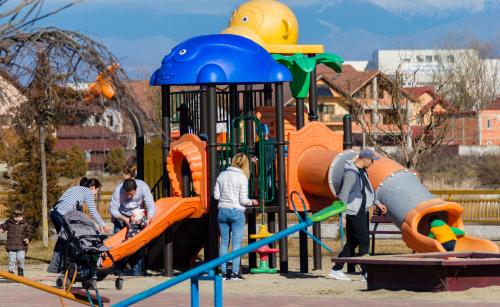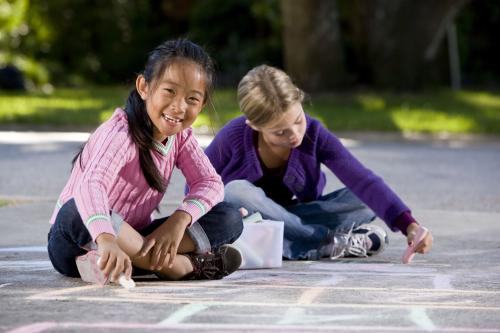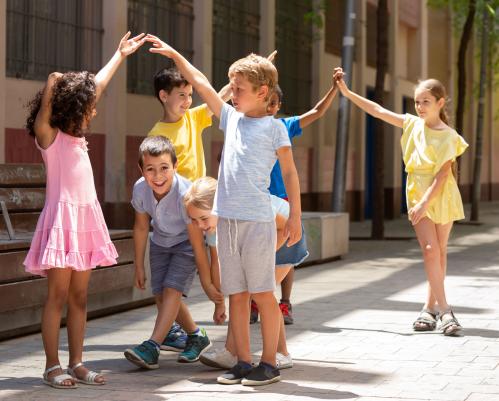Urbanization is on the rise and experts predict that by the year 2050 almost 70 percent of the world’s population will live in urban areas. With an increasing number of children growing up in urban environments, understanding the science and connections among healthy development, learning, and placemaking is critical for reimagining the potential of cities as supportive ecosystems for children and families.
To this end, Brookings launched the Playful Learning Landscapes (PLL) City Network in December 2020—bringing together city-level decisionmakers and stakeholders in a community of practice to support the design and uptake of evidence-based PLL practices and policies. The network consists of city teams from Chicago, Philadelphia, Pittsburgh, Santa Ana, and Tel Aviv. A key aspect of the network is co-creating the content and structure of the meetings with network members to maximize opportunities for peer learning, knowledge sharing, and network strengthening.
Playful learning projects often involve the coordination of city-level policymakers, community organizations, the private sector, and philanthropies. Moreover, stakeholder buy-in—getting key decisionmakers on board with the vision of a project and understanding the project’s goals—is critical for success. In our January 2022 meeting, city teams discussed obtaining stakeholder buy-in—a challenge that many teams face at different phases of playful learning projects. These were some of the key takeaways from the city presentations and discussion.
1. Thinking outside the box about community engagement can inform key design and implementation decisions of playful learning projects
The goal for PLL projects is to get buy-in from neighborhood residents, community-based organizations, and families that can contribute to and sustain all phases of a project including design, implementation, and maintenance of sites. Using a human-centered design process ensures that PLL installations not only reflect the cultural and historical needs and preferences of the community, but also engender a sense of ownership when the installations are complete. To move away from the traditional focus group model toward creating more inherently valuable experiences for community members, Mural Arts and Playful Learning Landscapes Action Network (PLLAN) created a community engagement board game as a way of understanding a neighborhood’s traits and characteristics. The game is being used to gather data in communities that are part of the Literacy-Rich Neighborhoods initiative in Philadelphia—a project funded by the William Penn Foundation that creates opportunities in a particular neighborhood for families to interact with materials, activities, and programs that spark caregiver-child conversation and foster at-home literacy practices. Participants draw pictures or write notes on cards in response to prompts that provide valuable data for the design process. For example, the “exploration” prompt reads: “You found a treasure map of your neighborhood that takes you through three magical learning spots. Draw the map.” Playing the game can generate information about the places in the community that people already value and see as literacy-rich learning spaces, which helps garner buy-in from community members.
 The community engagement board game is a playful way to understand what community members value and how they like to spend time with their children. Photo credit: Sahar Coston-Hardy, courtesy of PLLAN.
The community engagement board game is a playful way to understand what community members value and how they like to spend time with their children. Photo credit: Sahar Coston-Hardy, courtesy of PLLAN.
2. Obtaining buy-in from a range of stakeholders is critical for building important connections, especially in the early phases of a project
Beyond engaging the community members, it is important to get support from other stakeholders including advocates or “anchor organizations” that have trusted relationships with families (pediatricians, schools, and local elected officials) and can play an important role in supporting a project and getting families excited about bringing playful learning to a neighborhood. And don’t forget about kids—the activities and programs must be fun and meaningful, so kids want to engage with them. Getting designers onboard from the beginning helps to create installations that capture community cultures and values, as well as reflect the input of neighborhood residents. Equally important is getting the buy-in of philanthropists and policymakers to create more avenues for funding current and future projects, and to facilitate deeper discussions about the long-term vision of PLL initiatives.
3. Identifying a champion that can enthusiastically articulate the vision of a project can help build momentum for an initiative with a range of potential stakeholders
As mentioned previously, playful learning projects often require collaboration between local civic, philanthropic, and neighborhood groups. Given the complexity of these initiatives, having a champion can help create a shared vision that brings key stakeholders together. In Santa Ana, California, Assistant Professor Andres Bustamante at University of California Irvine (UCI) is leading a four-year project in collaboration with the Santa Ana Early Learning Initiative (SAELI) to co-design a series of playful learning spaces—located in urban areas that families frequent like bus stops, parks, and supermarkets—infused with STEM learning opportunities for children and families. Bustamante brought together city-level and school district leaders, developmental researchers from UCI and Temple University, and local parents, educators, and community members that are part of SAELI to create a shared vision for infusing public spaces in Santa Ana with playful STEM learning opportunities. Through community-based, participatory design research, Bustamante and his research team worked with caregivers in the community to co-design a series of bus stop installations that promote adult-child interactions. For example, the Lotería bus stop is based on a game that community members play with their children and provides opportunities to learn about shapes, colors, numbers, and iconic figures in the community.
 Children and their caregivers can engage in playful learning while waiting for the bus in Santa Ana. Photo credit: UCI/SAELI.
Children and their caregivers can engage in playful learning while waiting for the bus in Santa Ana. Photo credit: UCI/SAELI.
As we continue to navigate the challenges of COVID-19, it is clear that children need a wider range of enriching learning opportunities in the places they frequent daily. While many of these places may look different during the pandemic, infusing public and shared spaces with designs informed by the latest science of learning can provide much-needed opportunities for quality caregiver-child interactions, the kind of playful learning children crave, and access to programs and activities that support early development and stimulation for all children.
The Brookings Institution is committed to quality, independence, and impact.
We are supported by a diverse array of funders. In line with our values and policies, each Brookings publication represents the sole views of its author(s).








Commentary
Creating playful learning spaces in cities: The important role of stakeholder buy-in
February 3, 2022